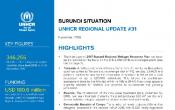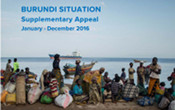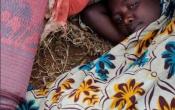Rwanda
Operation: Rwanda
Location
{"longitude":30,"latitude":-2,"zoom_level":8}
Latest update of camps and office locations 21 Nov 2016. By clicking on the icons on the map, additional information is displayed.
Key Figures
| 2017 planning figures | |
| 3,800 | households in camps will receive cash grants |
| 250 | people of concern in camps will be provided with entrepreneurship or business training |
| 6 | people of concern will share one shelter in camps |
| 100% | reported sexual and gender-based violence (SGBV) incidents will receive legal support |
| 70% | of people of concern in camps will have access to the national education system |
| 2015 end-year results | |
| 98% | of Congolese refugee children of primary-school age were enrolled in primary school |
| 82% | of Burundian refugee children of primary-school age were enrolled in primary school |
| 2,400 | individual resettlement submissions were made through the regional resettlement programme for Congolese (DRC) refugees, exceeding the target number of submissions |
| 99% | of Burundian refugees were registered through biometric registration during the emergency, enabling UNHCR to quickly identify and tailor assistance for people with specific needs, including unaccompanied minors |
| 97% | of deliveries were assisted by skilled health care professionals; there were 2,905 newborns in the year |
Latest Updates and Related Links
People of Concern
89%
Increase in
2015
2015
| 2015 | 151,173 |
| 2014 | 80,124 |
| 2013 | 81,490 |

[["Refugees",144737],["Asylum-seekers",414],["Returned refugees",5054],["Others of concern",968]]
Loading ...
Budgets and Expenditure for Rwanda
< Back
2015
{"categories":[2012,2013,2014,2015,2016,2017],"budget":[47.03959177,46.99329576,51.77383169,123.04000345,101.21378467,101.541134118],"expenditure":[20.00151131,24.80532645,19.3520492,39.48045656,null,null]}
{"categories":[2012,2013,2014,2015,2016,2017],"p1":[46.26031012,44.64886676,49.14538088,122.417859367,95.18270004,95.510049118],"p2":[null,null,null,null,null,null],"p3":[0.77928165,2.344429,2.62845081,0.622144083,6.03108463,6.031085],"p4":[null,null,null,null,null,null]}
{"categories":[2012,2013,2014,2015,2016,2017],"p1":[20.00151131,24.79354125,18.31857805,38.96277319,null,null],"p2":[null,null,null,null,null,null],"p3":[null,0.0117852,1.03347115,0.51768337,null,null],"p4":[null,null,null,null,null,null]}
Loading ...
CHOOSE A YEAR
- 2014
- 2015
- 2016
- 2017
Working environment
While the overall security situation in Rwanda remains calm, instability in neighbouring Burundi and eastern Democratic Republic of the Congo (DRC), where elections have been postponed to next year, continues to present the possibility of a sudden influx of refugees.Rwanda has been hosting refugees for decades and today it is home to nearly 165,000 refugees and asylum-seekers from the DRC and Burundi. The Government has maintained open borders and ensures freedom of movement and the right to work for all refugees.
Key priorities
UNHCR’s key strategy for 2017 is to further encourage the socio-economic inclusion of refugees and reduce dependency on humanitarian aid through a multifaceted strategy, including through the continued integration of refugees into national education and healthcare systems, and implementing a joint Government-UNHCR multi-year market-based livelihoods strategy. This strategy foresees a transition from in-kind to cash-based interventions, and includes strategic partnerships with the Government, development actors and UN agencies, to mainstream refugees into national programs.With women and children representing over 80 per cent of the refugee population in Rwanda, child protection and SGBV programs are being prioritized in all refugee locations. In addition, resettlement is also prioritized for Congolese refugees living in protracted situations.
A funding shortfall would impact UNHCR’s ability to upgrade the already overcrowded communal living spaces occupied by over 11,000 Burundian refugees and the temporary shelters of several Congolese refugee families, which present a range of health and protection risks. Funding is needed to ensure more dignified living conditions. UNHCR’s water, sanitation and health (WASH) programs have so far succeeded in achieving the minimum standards but further funding support is required to ensure the health of refugees.





